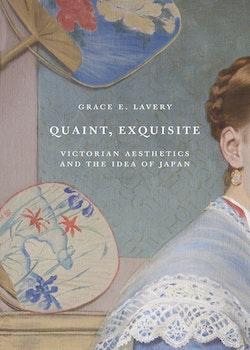Quaint, Exquisite: Victorian Aesthetics and the Idea of Japan

By Grace E. Lavery
Princeton University Press (2019)
ISBN-13: 978-0691183626
Review by Laurence Green
In any discussion of Japan, the words Quaint, Exquisite seem bound to appear at least once or twice, even now, over a hundred years since Japan first opened its doors to the world. What is it about the particular aesthetic qualities of the nation that ensure these attributes still hold such sway over our idea of what Japan is like, what it represents? Penned by the University of California, Berkeley’s Grace. E Lavery, this account seeks to remind us of the excitement and promise Japan held for the Victorian populace in particular, when many of these notions were first introduced. Japan as the ‘Other Empire’ – the world’s first non-Western modernity. Japan as the marked ‘exception’ to the general principle of orientalism – a higher calibre of exoticism.
Immense in its scope, and encyclopaedic in the sheer number of touch-points it tries to bring in to its core argument, this is a dizzying, remarkably ambitious account (especially considering it tries to accomplish all this within less than 200 pages). But from the introduction onwards, it quickly becomes apparent that we’re not in for an easy ride. Throwing the reader head-first into hyper-complex ideas of aesthetic and melancholy, via a stream of big name thinkers (Kant, Bourdieu, Freud, Lyotard and so on), this book isn’t for the faint hearted, or those with a dithering attention span. When the opening pages contain a self-acknowledged suggestion from readers to add a glossary of terms, but the definitions themselves only add further complexity, you know you’re facing some pretty significant problems with clarity.
Much like French theorist Roland Barthes’ The Empire of Signs, which this book is clearly immensely indebted to in terms of both style and content, it is not so much Japan that Lavery is interested in here, but the ‘idea’ of Japan. Amongst the various vignettes that Lavery presents, a number particularly stand out. Early on, we are given a vivid comparison of the novel Moby Dick – published in 1851 – as an allegory for American pursuit of Japanese trade, the ‘white whale’ of untapped commerce which would eventually open to the world following the Meiji Restoration.
We are then given a flavour of the Savoy Opera and the eccentricity of Gilbert & Sullivan’s The Mikado. Here, the reverence for a kind of mythological ‘Old Japan’ is strongest, the obsession with an exoticised ‘exquisite’ so prised by Victorian audiences most palpable. The stage is set for a period of ripe opportunism for all ‘Things Japanese’, as the foremost Japanologist of the era, Basil Hall Chamberlain, titled his popular one-volume encyclopaedia. We are told of Oscar Wilde’s love for issuing luxurious limited editions of his works in Japanese paper – an intensely desirable, premium commodity at the time. A section on Whistler’s paintings is charming too. They say a picture speaks a thousand words, and here it’s literally true – the inclusion of copies of the artist’s works (housed in the Tate Britain) sells the books idea of aesthetic far better than pages of dense theorising. The book’s cover image – Portrait of Emily Caroline Massingberd by John Collingham Moore (to be found in National Trust property Gunby Hall), is also very tastefully chosen; all prim Victorian modesty set against the thrill of pretty Japanese bamboo fans.
This swell of Anglo-Japanese cultural flow wasn’t all one-way. Lavery reminds us of author Natsume Soseki’s presence in London between 1900-1903. But perhaps most interesting is the case of Mikimoto Ryuzu, the son of famed pearl magnate Kokichi. We are given an account of Ryuzu’s exceptional collector-like passion for the works of Victorian art critic John Ruskin – something that would ultimately culminate in a library of material that exists in Tokyo to this day.
Unfortunately, some of Lavery’s other case studies are less convincing. A section on English language haiku, referencing Jack Kerouac and an internet meme from 2012 (“Five syllables here / seven more syllables there / are you happy now??”), falls particularly wide of the mark. In addition, it must be said that the book very much seems to assume prior knowledge of the cultural figures it references – very little preamble or biographical detail is typically given, and the reader is left to fill in the blanks. While there’s nothing wrong in getting the reader to work a bit, there’s a sense that the book would have benefitted from a more open, welcoming tone.
The irony is that the unrelenting nature of Lavery’s accumulation of disparate sources, all in aid of constructing her fascinating idea of ‘aesthetic’, begins to gradually grow on the reader. But when the book suddenly switches in its final chapter to a Film Studies-style close analysis of Asia Extreme classic Audition and the films of Quentin Tarantino, it’s undoubtedly one leap too far. The immense jump not only in time period, but also medium, feels bizarre, and the volume would have felt far more consistent – more ‘of a piece’ – without this last instalment.
There is a trend, particularly within American academia right now, for the kind of hyper theorised discourse Lavery takes with this book, where the sheer impenetrability almost becomes part of its aesthetic. It becomes a kind of game, a one-upmanship of amassed knowledge condensed down into thesis form. But for all that this approach boasts in style, hip jargon and a multitude of ‘clever’ pop cultural references, it remains distinctly lacking in simple, old-fashioned readability. Academic audiences and a more general readership shouldn’t necessarily be mutually exclusive. Lavery presents a treasure trove of interesting ideas here, but with a tighter focus and a good sight more clarity, this would have made for a far more engaging study.

